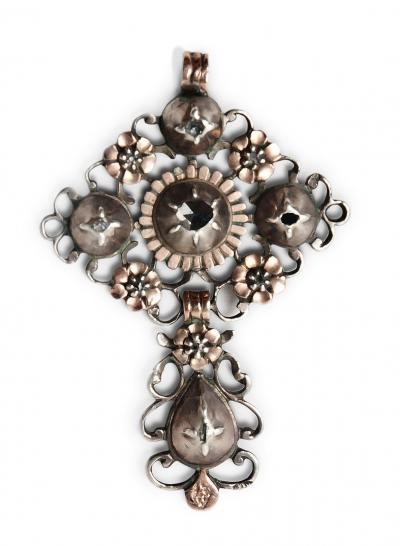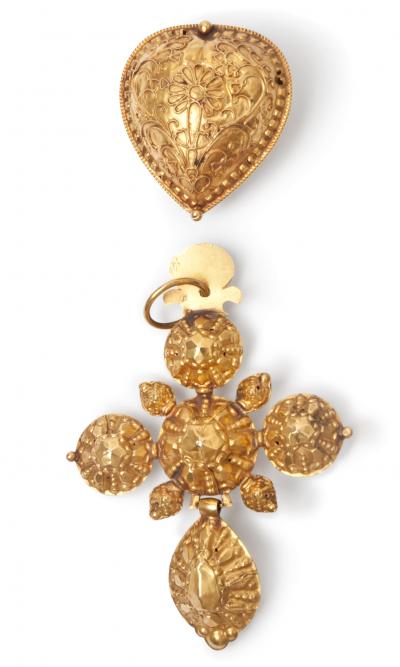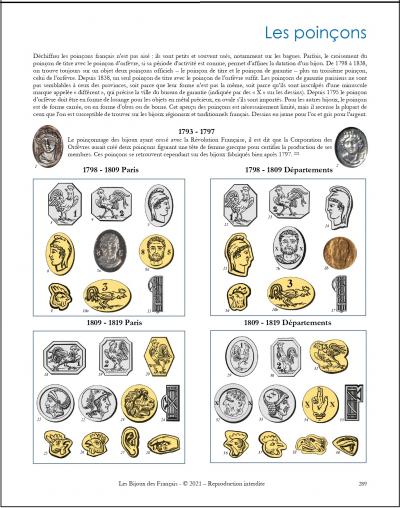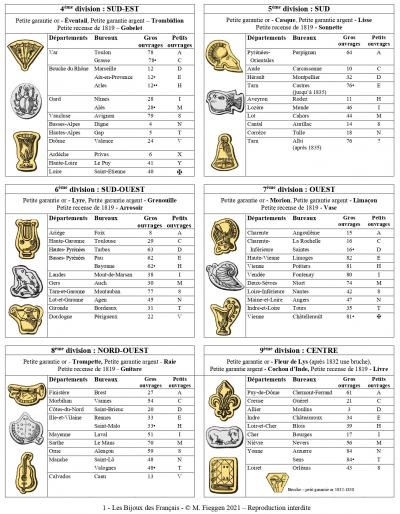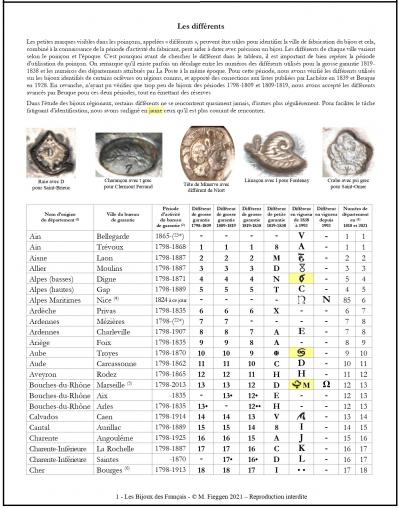Picardy

French regional jewelry - Picardy
The Amiens cross
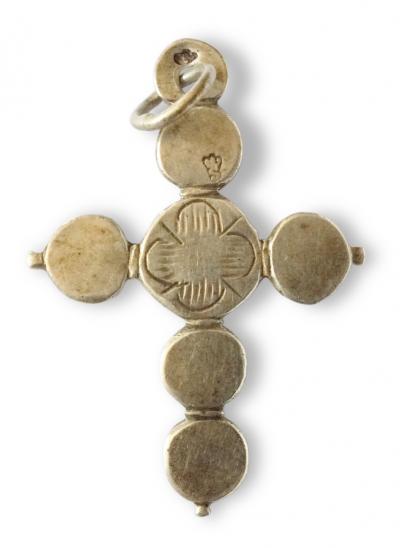
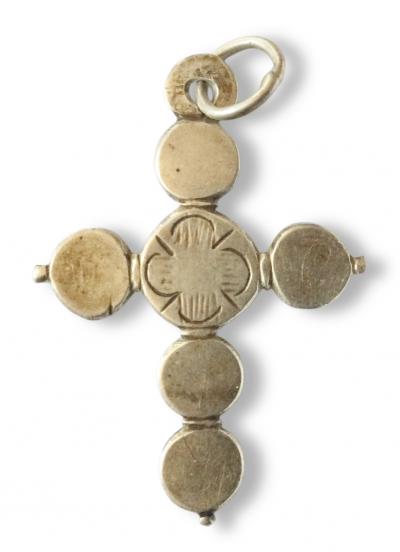
Amiens cross in silver
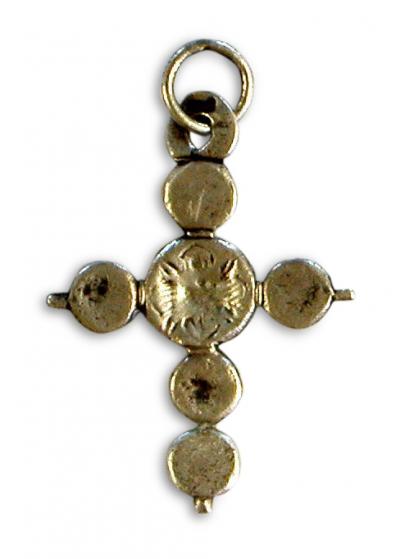
Amiens cross in silver

Amiens cross in silver
The Flemish cross
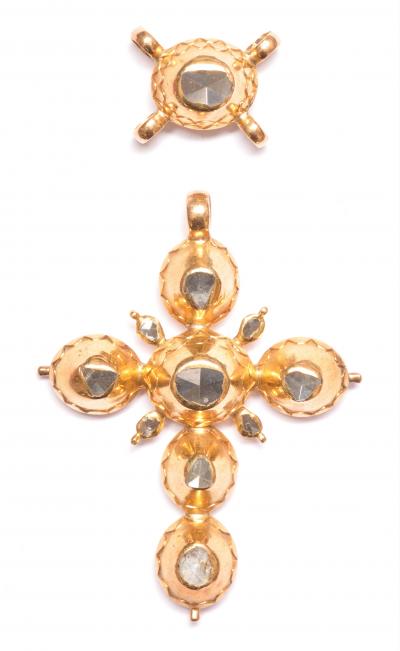
Flemish cross with slide in
gold, set with rose cut diamonds |
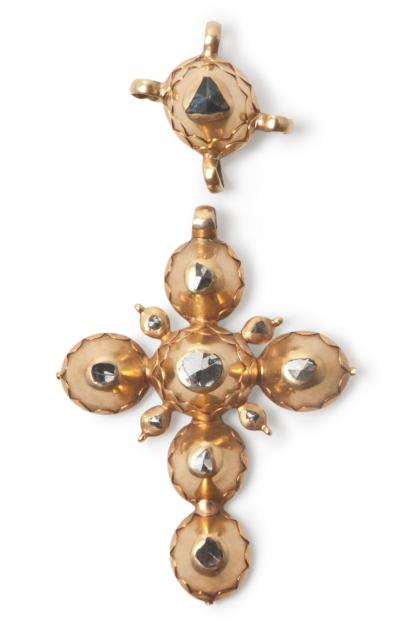
Flemish cross with slide in
gold, set with rose cut diamonds |
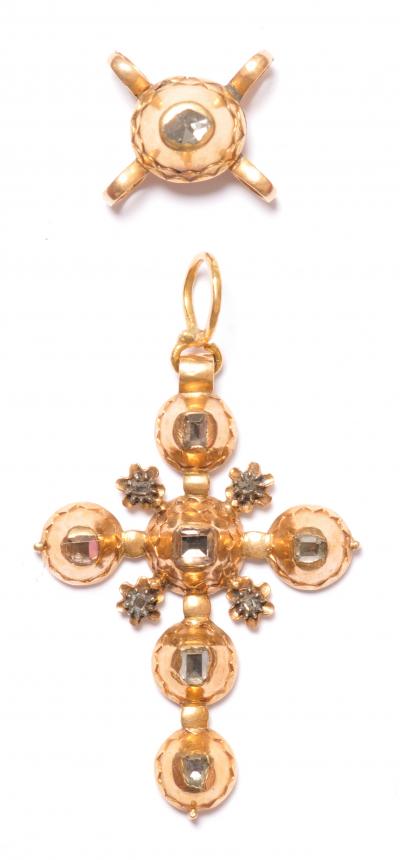
Flemish cross with slide in
gold, set with table cut diamonds |
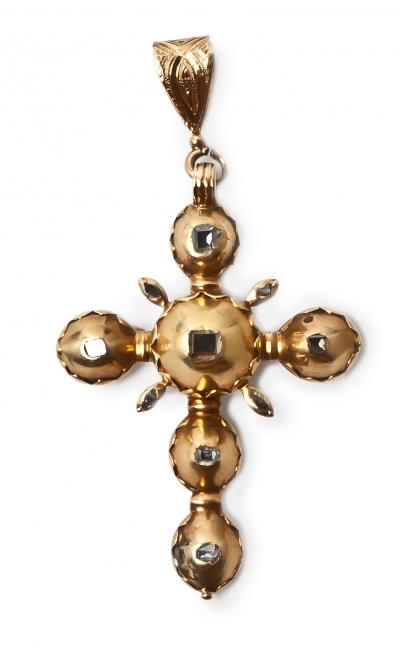
Flemish cross in gold, set with table cut diamonds
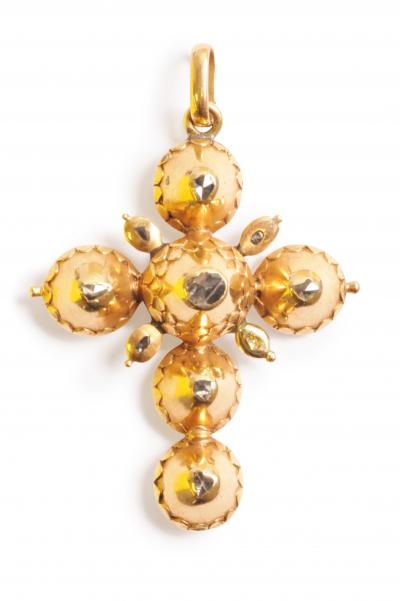
Flemish cross in gold, set with rose cut diamonds
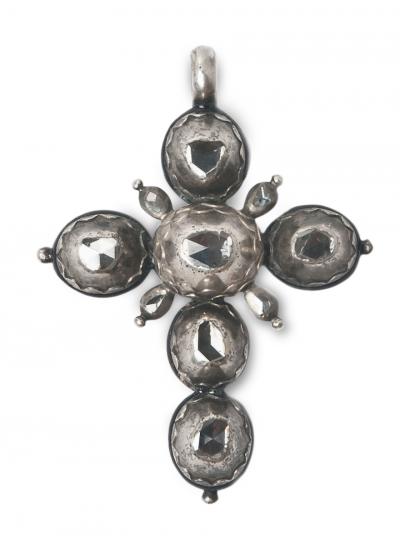
Flemish cross
in silver set with rose cut diamonds |
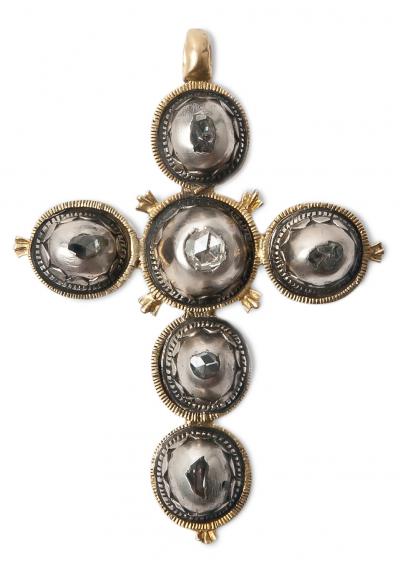
Flemish cross
in gold and silver set with rose cut diamonds |
These crosses are frequently found in the region running from Compiègne as far north as Lille and as far west as Amiens, but never on the coast where the Boulogne and other Flemish crosses dominate. They are in fact Flemish crosses made and worn in southern Belgium, where they are relatively common and while they exist perhaps in other regions of France, I've not come across any others at this time apart from one found in Vierzon.
One should consider them as Belgian crosses that were adopted in this part of France, bearing in mind that Flanders was occupied by France at the time they were produced and worn. Examples in silver have been identified with the boar's head hallmark, proving that some at least were made in Paris, though they are most likely to to be later re-editions made for the tourist market and also to be sold when there was a popular fashion for wearing "peasant" jewellery at the end of the 19th century..
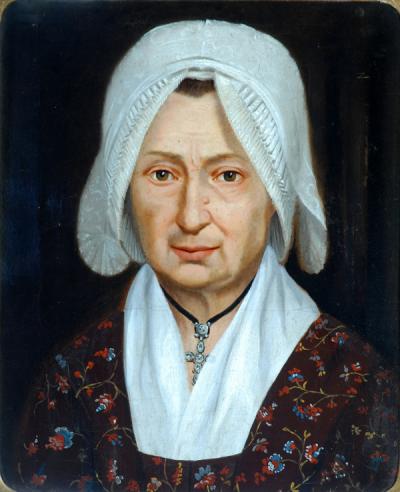
woman from Picardy with cross painted by Jean Louis Elshoecht, (1760 - 1841), painted circa 1805,
The Bowes Museum, England
, 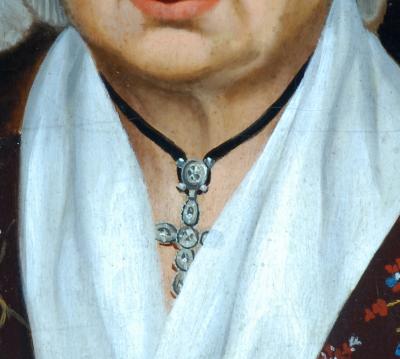
Jean Louis Elshoecht (1760 - 1841), woman from Picardy with cross (detail), painted around 1805,
reproduced by kind permission of The Bowes Museum, England

Cross in gold and Rhinestones
This cross was purchased in 1869 by the Victoria et Albert museum of London and was said to be worn in Picardy. Other exampleS can be found in the Martainville museum and the Mucem.
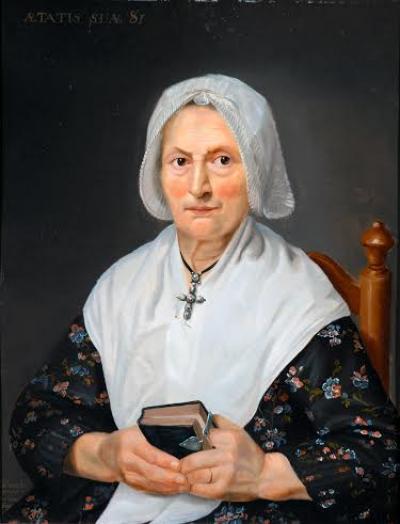
woman from Picardy with cross, painted by Jean Louis Elshoecht (1760 - 1841), painted 1805,
by kind permission of The Bowes Museum, England

woman from Picardy with cross (detail) by Jean Louis Elshoecht (1760 - 1841), painted 1805,
reproduced by kind permission of The Bowes Museum, England

silver cross worn in Normandy
painting displayed in the musée des traditions et arts normands, Martainville

Flemish cross in gold & silver, set with rose cut diamonds
note how the slide is the same as those on the Belgian Jeannette crosses
Collected in Vierzon
La croix de Liesse - the Liesse cross
The basilica of Liesse was an important centre of pilgrimage since the twelfth century and Our Lady of Liesse was actively worshipped in Normandy and other parts of France. In the eighteenth century a jeweller in the town of Liesse, in Picardy, Mr. Bailly, exported large numbers of crosses to Normandy. Marguerite Bruneau in her book Histoire du Costume Populaire en Normandie, tome 1, gives details on how much money some bankrupt jewellers in Normandy owed to Mr. Bailly and the figures are quite considerable. (1)
|
We know very little about the Liesse cross. Many were exported to other regions and yet none is mentioned under that name in the wills and documents that we can examine. It is likely that examples of the cross exist but are at the moment known by different names. A nineteenth century description of the cross gives us a few clues – “It was a badly stamped cross made in two halves, the upper and lower parts very thin. The settings and raised parts were filled with plaster which gave it rigidity and weight. This cross was inexpensive and was made almost exclusively in silver. It was made mainly in Paris.” (2)
We can assume that if the jewellers in other regions imported these crosses, it was because the manufacturer had a commercial advantage and could make them cheaper than his clients. This would be the case if the crosses were stamped, as the material required to make them is expensive and requires large production runs to be amortised.
|
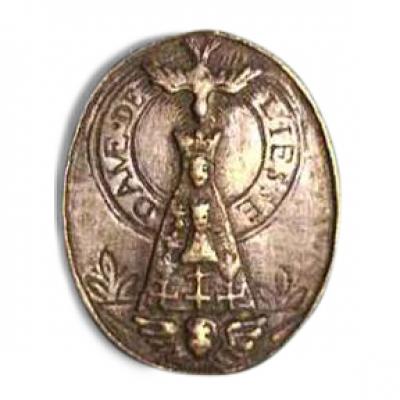
medal from Notre Dame de Liesse, bronz
|

cross from Notre Dame de Liesse, bronze
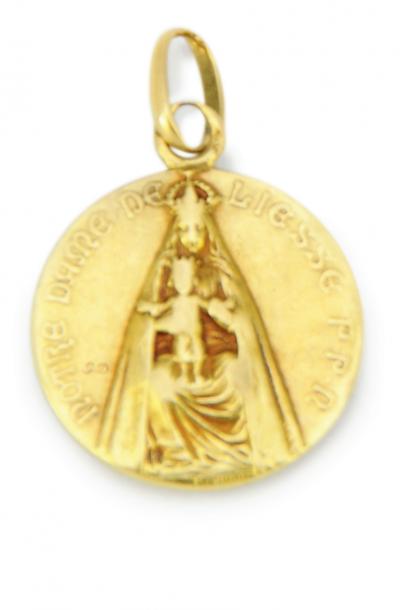
medal from Notre Dame de Liesse, gold (200%)

pilgrim's cross from Notre Dame de Liesse in brass, reverse |
|
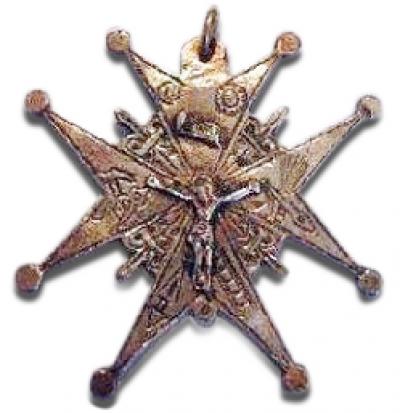
pilgrim's cross from Notre Dame de Liesse in brass, obverse |
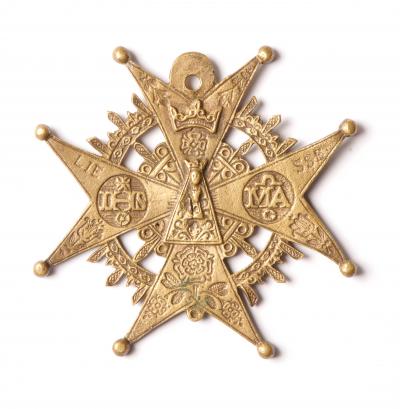
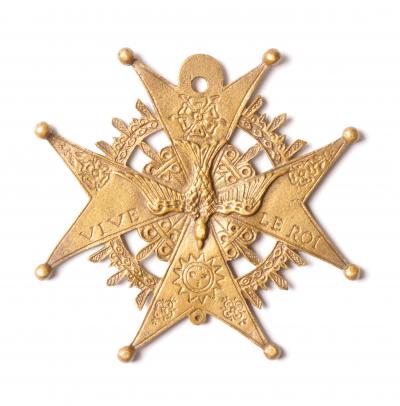
pilgrim's cross from Notre Dame de Liesse in brass, obverse and reverse, actual size
The only crosses that seem to fit this description are the papillon cross, the Flemish cross and the bosse cross. The former is indeed found in other parts of France, even in the south, while the Flemish cross is certainly inexpensive when in silver and filled with plaster, though I have not found any outside of Picardy for the moment. Marguerite Bruneau, in her book "Les Bijoux Normands", leans towards the bosse cross, though this cross is found only very occasionally in other regions. (3) The problem is that despite several books mentionning bosse crosses filled with plaster or horse-hair, I haven't come across a single filled one, and I have to conclude that that if any bosse crosses filled with plaster exist, that they were so modified by their owner and not by the jeweller. For example, not a single bosse cross in the collection of the museum of Martainville is filled.
If I had to lean one way, I would go for the papillon cross, which is common in the south of France and yet quite similar to those found in the south of Belgium. It is likely that a jeweller in Liesse, faced with a demand from pilgrims, would copy a southern Belgian cross already locally popular and that these crosses would spread throughout the country around the necks of pilgrims. Any information you might have to clear up this mystery is welcome. PM
It's interesting however to observe the evolution of the Flemish butterfly cross (croix papillon or croix à la Jeannette) with time. The third cross shown below has the form of the Picardy cross yet it has retained a reduced version of the upper section of the papillon cross. The next cross has a slide which has evolved to retain only the diamond-set cone from the previous version. Perhaps there never was a single Liesse cross but a succession of crosses which changed to follow the fashion of the time......
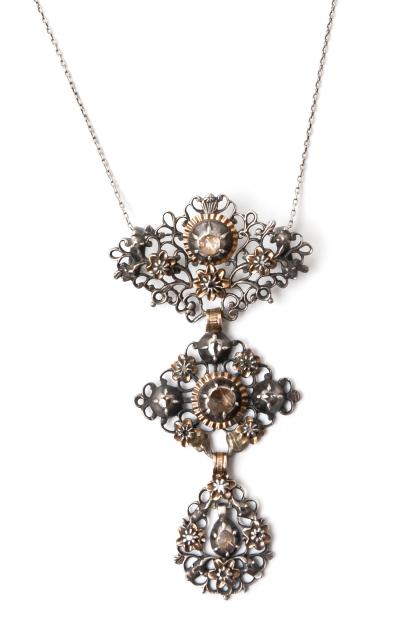
Flemish butterfly cross,
c1800-1840, gold,
silver and diamonds |
|
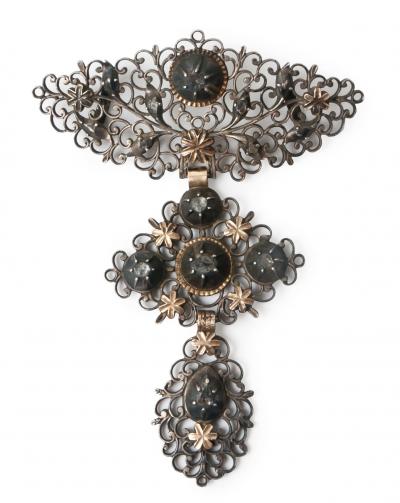
Flemish butterfly cross,
c1800-1840, gold,
silver and diamonds
|
|

Flemish cross in gold & silver, set with rose cut diamonds
note how the slide is the same as those
on the Belgian Jeannette crosses
|
|
|

Flemish cross with slide in gold, set with table-cut diamonds |
|

Flemish cross with slide in gold, set with rose-cut diamonds
|
|
The history of the basilica of Our Lady of Liesse is extremely interesting, you can click here for a link to their website.
(1): - François Drouet, marchand orfèvre à Doudouville doit 1.177 livres (1789)
- Pierre Maloiselle, marchand bijoutier d'Ivril la Chausée doit 522 livres (1789)
- François Joutel, laboureur-bijoutier à Bretteville en Caux doit 1284 livres (1786)
- Vincent Coignard, marchgand orfèvre bijoutier à Rouen doit 1284 livres (1786)
9 UP2 à p6 Archives Départementales de la Seine Maritime
(2): Lettre citée par E. Colin dans "Le mois à Caen". 8e année n°80.
(3): BRUNEAU, Marguerite., Les bijoux normands, Cercle d'action et d'études normandes, 1976 *****
contents::
Croix picarde, croix de Picardie, bijou régional, bijoux régionaux, Jean Louis Elshoecht, les bijoux traditionnels Français, bijoux des régions de France, croix de Rouen, croix bosse, croix régionale, bijoux picards, traditional French jewellery, jewelry, French regional jewellery, croix Jeannette, Marguerite Bruneau, croix de Liesse- antieke zeeuwse streeksieraden in zeeland friesland - Brabantse klederdrachten en streeksieraden
French regional jewelry - Picardy
New book - Traditional French Jewellery
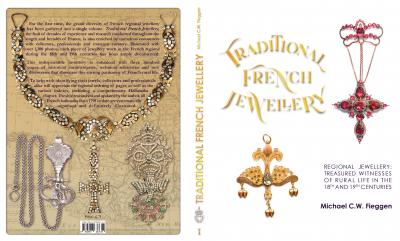
Book - Traditional French Jewellery - order here direct from the author
Dear collectors, auctioneers, dealers and jewellery lovers,
You have visited the site www.bijouxregionaux.com which since 2009 has listed all regional and traditional French jewellery, without advertising and without sales. By popular demand, this website is now finally available as a book, much more complete and with many new photos and texts that are not on the site. I traveled more than 4,500 km in 2020 to visit the various collectors and museums of France and to photograph, weigh, measure and examine their jewellery.
Large format of 23.5 x 30 cm, 304 pages, hardcover and fully illustrated with over 1300 jewels in color, this book is the first complete book on French regional jewellery and corrects the many errors and gaps observed in the other references and presents other regional jewels hitherto unknown to the public. You will find eight full pages on Breton pins and fibulae and many other jewels in museums and private collections that are not on this website. Over four months of research has gone into making the chapter on hallmarks the most reliable ever seen - clear illustrations of hallmarks have been made especially for this volume. And for the first time, collectors will have access to a complete list of all the assay office symbols, small signs withn the hallmarks that identify in which city the jewellery was hallmarked. The opening and closing dates since 1798 of the hallmark offices are also listed for the first time, allowing, with the office symbol, to better date your jewellery.
The print run of this book is very limited, which is why I recommend you order early. You will love this book I have had nothing but compliments and many clients have ordered more to offer as gifts.
To order, you can send a wire transfer or WISE transfer to Michael Fieggen - FR76 4061 8803 9700 0403 3233 171 – BIC – BOUSFRPPXXX - address Mike Fieggen, 280 rue Saint Honoré, Paris, 75001 France
Bank or wire transfer by www.wise.com in Sterling – Account holder - Michael Fieggen
IBAN - GB68TSBS30916200184462 BIC / SWIFT - TSBSGB2AXXX
Sterling cheques and PayPal welcome to address demosthenesparis@gmail.com.
Any questions ? Contact me at bijouregional@gmail.com or by telephone at + 33 1 4015 9000
One copy in French €75 Postage and packing €9 for France, €8 for Europe and overseas
Two or more copies in French €75 each Postage and packing €9 for the lot in France, overseas postage €8 each
One or more copies in English £75 sterling each Postage and packing £8 sterling each






























